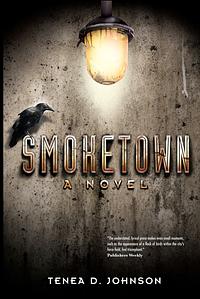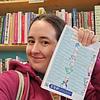Take a photo of a barcode or cover
Too much jumping around--nonlinear narrative itself is fine, but you gotta mark when you're changing time periods if you want me to follow the plot.
Could have used with more explanation on her ability. Besides that, awesome!
slow-paced
Plot or Character Driven:
Plot
Strong character development:
No
Loveable characters:
No
Diverse cast of characters:
Yes
Flaws of characters a main focus:
Complicated
This is an interesting concept for a novel, but poorly executed. The multiple POV introduced many characters but left them all underdeveloped. Had this book been longer, it would have been a DNF. One star for brevity, one star for character diversity.
adventurous
dark
mysterious
reflective
slow-paced
Plot or Character Driven:
Plot
Strong character development:
No
Loveable characters:
Yes
Diverse cast of characters:
Yes
Flaws of characters a main focus:
Complicated
This was an interesting little novella. The world building had solid legs, there were some truly unique aspects. However, there were just some things that were left unexplained that made it more difficult to be totally immersed. I think this suffered from too many good ideas, imperfect execution. The characters were strong but the reader didn’t get to spend enough time getting to know them. It’s rare that I say a book should have been longer but I think this story deserved some extra space. Will definitely be on the lookout for more from this author.
mysterious
reflective
slow-paced
Plot or Character Driven:
Character
Strong character development:
Complicated
Loveable characters:
Complicated
Diverse cast of characters:
Yes
Flaws of characters a main focus:
Complicated
Smoketown is a novel that’s hard to categorize. It’s got elements of the post-apocalyptic, dystopian, and urban fantasy. And the writing is simply lovely! So lyrical and beautiful. There’s a reason I’ve compared this one to the books of Charles de Lint. Really, it’s a huge shame that more people haven’t heard of Smoketown.
Twenty years ago the city of Leiodare, a futuristic city-state located in the former state of Kentucky, was struck by a plague. Birds were perceived to be the cause, and so birds were banned from Leiodare. Now Anna Armour, an artist and factory worker, is waiting in Leiodare in hopes of finding the woman she loved who left her. Anna also has a strange gift – she can use her art to bring her creations to life. Also in Leiodare is Eugenio, a medical anthropologist investigating the cause of the original plague, and Rory, the last member of the city’s most privileged family, who spends his remaining days watching the world go by from the windows of his apartment.
Smoketown is not plot focused. While there was a plot behind the origins of the plague and the history of the city, I found it weakly contrasted and not very compelling. The plot actually ended up feeling extraneous to the characters and atmosphere.
The focus of Smoketown is clearly on the world building. The city of Leiodare leaps off the page incredibly vividly. It was a beautiful piece of world building. I feel like it went very well with some of the themes of the book – change and creation mostly. There’s a sense of artistry to the entire novel.
If you’re looking for an exquisitely dreamy piece of genre blurring science fiction and fantasy, Smoketown is just the book for you. I would also recommend it to anyone with an interest in queer black science fiction.
Originally posted on The Illustrated Page.
Twenty years ago the city of Leiodare, a futuristic city-state located in the former state of Kentucky, was struck by a plague. Birds were perceived to be the cause, and so birds were banned from Leiodare. Now Anna Armour, an artist and factory worker, is waiting in Leiodare in hopes of finding the woman she loved who left her. Anna also has a strange gift – she can use her art to bring her creations to life. Also in Leiodare is Eugenio, a medical anthropologist investigating the cause of the original plague, and Rory, the last member of the city’s most privileged family, who spends his remaining days watching the world go by from the windows of his apartment.
Smoketown is not plot focused. While there was a plot behind the origins of the plague and the history of the city, I found it weakly contrasted and not very compelling. The plot actually ended up feeling extraneous to the characters and atmosphere.
The focus of Smoketown is clearly on the world building. The city of Leiodare leaps off the page incredibly vividly. It was a beautiful piece of world building. I feel like it went very well with some of the themes of the book – change and creation mostly. There’s a sense of artistry to the entire novel.
If you’re looking for an exquisitely dreamy piece of genre blurring science fiction and fantasy, Smoketown is just the book for you. I would also recommend it to anyone with an interest in queer black science fiction.
Originally posted on The Illustrated Page.
This was a little better than ok. The story is good, the structure of the story-telling was good, but the writing itself -- the way the words worked together on me as a reader -- was weak. The story has a dreamy, magical element to it in terms of the actual facts of the story but that dreamy magic never found its way into the author's language. There were parts that I felt could have been fleshed out more -- easily about 100 more pages worth of material -- but I found that I didn't really want to read what the author would have written if she had done so. The ending is decent though I can't say that I liked the epilogue chapters terribly much. My feeling after the very last chapter, with the encounter with Peru that doesn't really seem to be saying anything about anything in the book up to that point , almost lead me to give this 2 stars but the story really was good enough that the even the weak language and the not-terribly-fulfilling epilogue didn't really warrant the demotion.
mysterious
fast-paced
Plot or Character Driven:
A mix
Strong character development:
Complicated
Loveable characters:
Yes
Diverse cast of characters:
Yes
Flaws of characters a main focus:
Complicated
In what we now think of as Appalachia, Leiodare is a jungle due to pharma companies destroying the climate. Twenty-five years ago, an epidemic hit Leiodare called 'The Crumble,' and even though the quarantine of the city has been lifted, it's still not the same. Birds were blamed for the epidemic, and thus have been banned - with a sonic wall guarding the city and check-points at all entrances and exits. Anna is there awaiting her love's return when she re-discovers her power to make drawings that come to life by drawing a pair of swans that become real. But did birds really cause The Crumble?
.
I loved reading this book. It had just enough world building and drew out all of the various groups and coping mechanisms for this society left behind after the epidemic. It's filled with small details about the different neighborhoods and how they interact - there's even an insect problem due to the lack of birds. There's a wild twist in the middle that... I'm not sure how I feel about? But enjoyed this tale nonetheless.
.
I loved reading this book. It had just enough world building and drew out all of the various groups and coping mechanisms for this society left behind after the epidemic. It's filled with small details about the different neighborhoods and how they interact - there's even an insect problem due to the lack of birds. There's a wild twist in the middle that... I'm not sure how I feel about? But enjoyed this tale nonetheless.
I really enjoyed the book. Excellent story, great story-telling, a lovely afternoon read.




